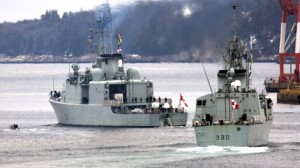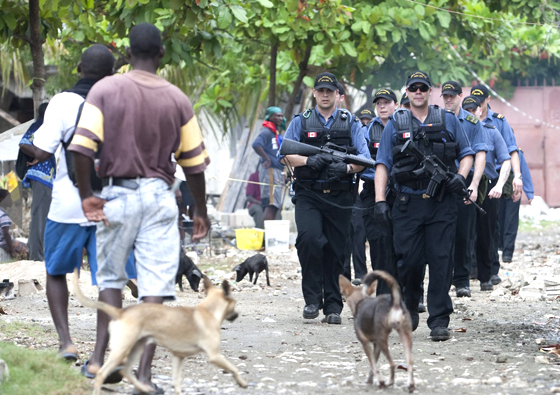by Roger Annis
Published in Haiti Liberte, Vol 3 #12, October 6, 2010
For the past several months, the Canadian armed forces have staged speaking events in cities across Canada to vaunt its role in Haiti in the month following the earthquake. Vancouver got its turn on Sept. 17 when one of the commanders of the two warships sent to Haiti shortly after the earthquake spoke at two events.
Commander Josée Kurtz of HMCS Halifax spoke before a small public forum hosted by the Liu Institute for Global Issues at the University of British Columbia. For several weeks prior, the Institute featured a large photo display at its entrance of the military's presence in Haiti following the earthquake, a mission it calls Operation Hestia.
 Commander Kurtz's ship arrived eight days after the earthquake and was stationed off Jacmel for five weeks; the sister ship, HMCS Athabasca, was stationed off the coast of Léogane for the same duration. The Halifax carried a full complement of 250 sailors as well as close to 200 Canadian soldiers.
Commander Kurtz's ship arrived eight days after the earthquake and was stationed off Jacmel for five weeks; the sister ship, HMCS Athabasca, was stationed off the coast of Léogane for the same duration. The Halifax carried a full complement of 250 sailors as well as close to 200 Canadian soldiers.
The commander stated that the fundamental mission of both ships was to provide "security and stability" in and around their assigned areas, Jacmel and Léogane. She gave an overview of the ships' work during their five weeks of service, saying the goal was to "save lives, mitigate suffering and assist the onshore activity of Canadian and other police, military and aid agencies."
"We didn't provide care in the beginning," she said. "Our first task was to secure order."
Once order was deemed established, the ship's crew began to assist with tasks like removing small amounts of rubble and building latrines, kitchens and water distribution facilities. One of the first jobs was to clear trees at the Jacmel airport to allow large transport aircraft to land. No crew members stayed onshore overnight, said the commander, due to potential "danger" from Haitian civilians.
HMCS Halifax provided no medical aid to the civilian population, the commander stated. It assisted the modest medical service of the Canadian military's Disaster Assistance Relief Team (DART) that was already onshore when the Halifax arrived. As a study by John and Emily Kirk in April 2010 reported, the Canadian military provided no surgical assistance to Haiti following the earthquake. Its medical presence amounted to a first-aid station that would refer cases requiring serious medical attention to other services in the immediate region or in Port-au-Prince.
It's worth noting that Canada's Prime Minister did not give "security and stability" as the two ships' mission when they set sail, nor since. "Ships of the Atlantic fleet were immediately ordered to Haiti from Halifax, loaded with relief supplies," PM Stephen Harper said at the time.
"Sailors didn't take aboard much in the way of relief aid – food packages, medical supplies or shelters – for distribution to Haitians," reported the Halifax Chronicle Herald on March 12, 2010 (the article has disappeared from the newspaper's website.)
The CBC had a reporter and photographer embedded on the ships. They didn't report on any supply missioning either. One wrote, "The 41-year-old HMCS Preserver, the navy’s only east supply ship, could work wonders here. Its big belly full of food and medical aid, its shore launches and its extra hangar space would be welcome.
"But it’s not to be."
The Chronicle Herald reported that, according to opposition critics, "Harper doesn't seem to know what he's talking about." The ships, it seems, were "loaded" mainly with soldiers and guns.
"During the voyage," the story said, "some sailors wondered if the ships might have been better off staying in port a little longer – say 12 hours – to take on more relief supplies, food aid and medical equipment before sailing for Haiti."
Nothing that Commander Kurtz reported to the Sept. 17 forum contradicted the newspaper report.
The Canadian naval mission stayed in Haiti for five weeks. When the HMCS Halifax departed, it did so in a disruptive and destructive fashion, as the Mar. 23 Globe and Mail reported at the time. The mission took its mobile air traffic control equipment with it, along with the heavy lift equipment it had temporarily installed at the Jacmel port. To this day, Jacmel's roads and neighborhoods remain littered with rubble and most of the region's earthquake victims still live in deplorable conditions.
Commander Kurtz summed up the mission's work by saying, "It proved Canada's capacity to deploy in places struck by natural disaster. The officers and sailors in the Canadian Navy remain ready to deploy to other places, confirming Canada's commitment to international engagement."
The commander trumpeted primarily Canada's capacity to "deploy" abroad. But deploy for what purpose? Why hasn't the Canadian government (or its allies) "deployed" personnel and heavy equipment to help Haitians remove earthquake rubble, repair roads and bridges, rebuild electrical and communications infrastructure or essential public institutions like schools and hospitals, improve medical services, and so on?
During the discussion period of the UBC forum, the commander acknowledged there are serious questions to be asked about Haiti's state of affairs but said she was not in a position to voice her frank opinion.

